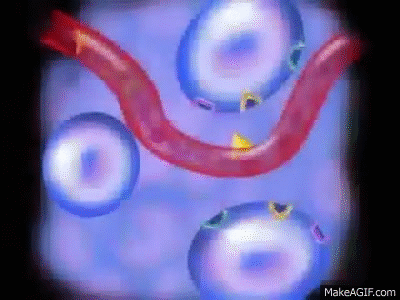This system consists of all the glands, and hormones that come from the glands. The nervous system acts to stimulate these glands along with chemical receptors from blood, and hormones of the other glands. Glands work to allow homeostasis for the digestion, heart rate, cellular metabolism, reproduction, and sexual development. Hypothalamus, pineal, pituitary, parathyroid, thyroid, thymus, adrenal, gonads, and pancreas glands are all the anatomical parts of this system. Each of these parts produce their own hormone to regulate for the area they are in. The endocrine works closely with the nervous system, however the endocrine system takes longer to process, and has widespread effects. The hormones from this system enter the bloodstream after being released. They then must find the appropriate receptor in a cell to bind to. The nervous system is able to control the levels of hormones in the body so that they are not imbalanced. There are two classes of hormones which are water soluble or lipid soluble.
afferent arteriole: a group of blood vessels that supply the nephrons in many excretory systems.
Bowman’s capsule: a capsule-shaped membranous structure surrounding the glomerulus of each nephron in the kidneys of mammals that extracts wastes, excess salts, and water from the blood.
efferent arteriole: blood vessels that are part of the urinary tract of organisms.
Excretion: the process of eliminating or expelling waste matter.
filtration: the action or process of filtering something.
filtration pressure: net driving force which pushes fluid into tissue spaces and out of vascular sites
Glomerulus: a cluster of nerve endings, spores, or small blood vessels.
Kidney: each of a pair of organs in the abdominal cavity of mammals, birds, and reptiles, excreting urine.
metabolic wastes: substances left over from metabolic processes (such as cellular respiration), which cannot be used by the organism
nephron: each of the functional units in the kidney, consisting of a glomerulus and its associated tubule, through which the glomerular filtrate passes before emerging as urine.
Osmosis: a process by which molecules of a solvent tend to pass through a semipermeable membrane from a less concentrated solution into a more concentrated one, thus equalizing the concentrations on each side of the membrane.
passive transport: movement of ions and other atomic or molecular substances across cell membranes without need of energy input.
peritubular capillaries: tiny blood vessels, supplied by the efferent arteriole, that travel alongside nephrons allowing reabsorption and secretion between blood and the inner lumen of the nephron.
Reabsorption: process by which the nephron removes water and solutes from the tubular fluid (pre-urine) and returns them to the circulating blood.
renal artery: supply the kidneys with blood.
renal cortex: part of the kidney where ultrafiltration occurs.
renal medulla: innermost part of the kidney.
renal vein: veins that drain the kidney
secretion: a process by which substances are produced and discharged from a cell, gland, or organ for a particular function in the organism or for excretion.
Urea: a colorless crystalline compound that is the main nitrogenous breakdown product of protein metabolism in mammals and is excreted in urine.
ureter: the duct by which urine passes from the kidney to the bladder or cloaca.
Urethra: the duct by which urine is conveyed out of the body from the bladder, and which in male vertebrates also conveys semen.
uric acid: produced during the breakdown of purines, which are found in certain foods and are also formed by your body. Once produced, uric acid is carried in your blood and passes through your kidneys, where most of it is filtered out into the urine.
urinary bladder: a hollow muscular organ in many animals, that collects and stores urine from the kidneys before disposal by urination. In the human the bladder is a hollow muscular, and distensible (or elastic) organ, that sits on the pelvic floor.
urine: a watery, typically yellowish fluid stored in the bladder and discharged through the urethra. It is one of the body's chief means of eliminating excess water and salt and also contains nitrogen compounds such as urea and other waste substances removed from the blood by the kidneys.

https://i.makeagif.com/media/12-04-2015/WzsZCp.gif
http://content.teachengineering.org/content/cub_/lessons/cub_human/cub_human_lesson07_header_image_new.jpg
No comments:
Post a Comment